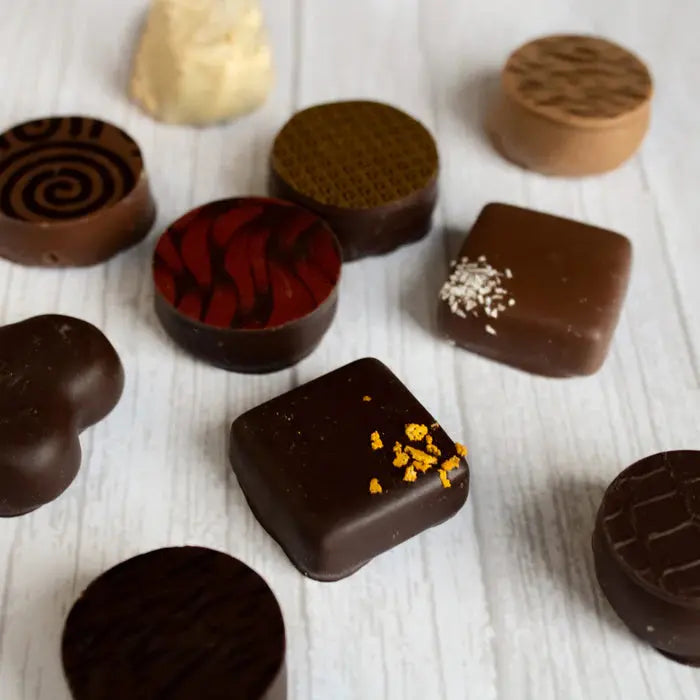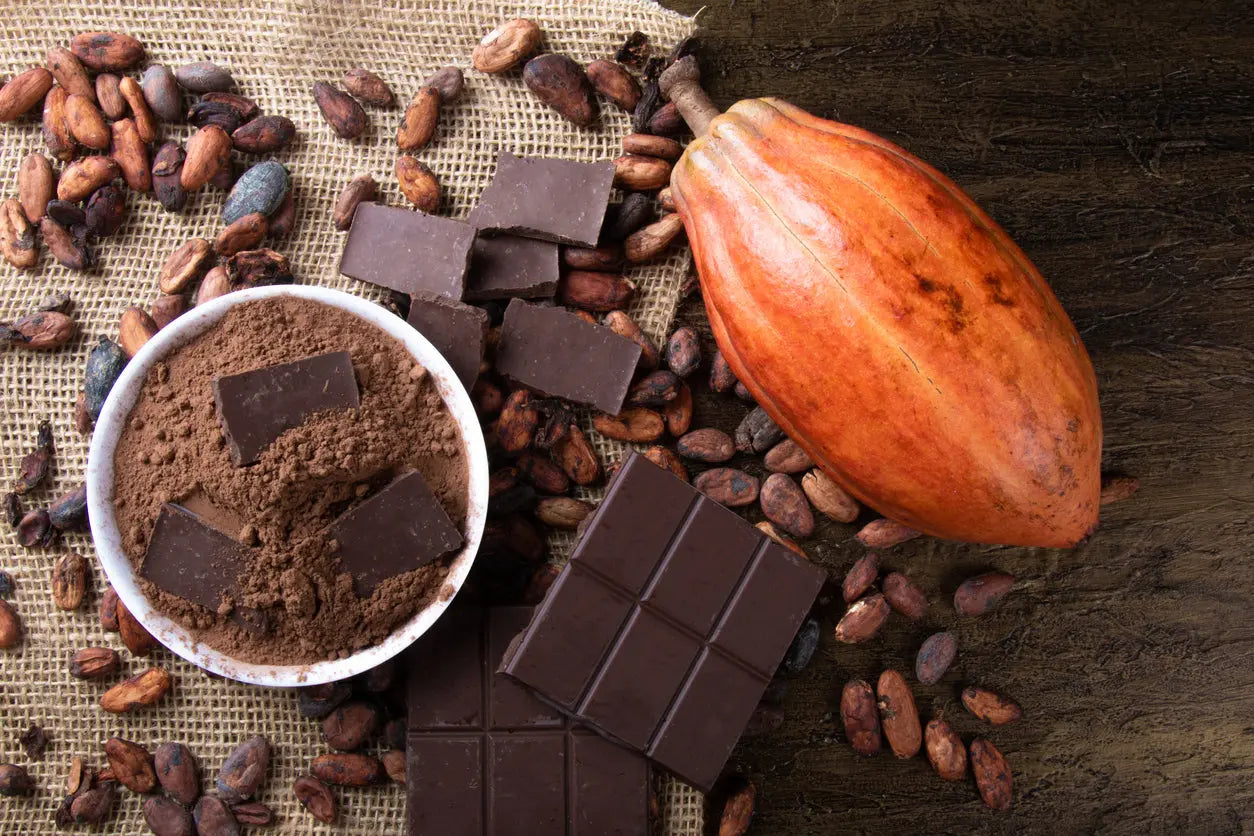Most people agree that chocolate is one of the most wonderful foods in the world. From afternoon pick-me-ups to romantic showcases of affection, chocolate is a true crowd-pleaser. However, few know about its rich history.
At Love Cocoa, we think that this legendary treat deserves some extra appreciation. So, without further ado, let’s take a look at where chocolate comes from and the cultures behind it.
Who invented chocolate?
Since chocolate is something we’re surrounded by every day in supermarkets, gift shops and kitchen cupboards, it’s hard to imagine a time without it. But the cacao-rich treat must have come from somewhere! Let’s explore chocolate’s fascinating roots.
The history of cacao
It’s unclear who exactly invented chocolate. However, we do know that the consumption of cacao was widespread in Mesoamerican civilisation — the complex of indigenous cultures in Mexico and Central America.
Historians have traced cacao use to a time as distant as 5,300 years ago — to the ancient Mayo-Chinchipe culture in the upper Amazon area of Ecuador.
More “recent” traces of chocolate have been discovered too. For example, in Mexico, Olmec pots from around 1500 B.C. were found to contain theobromine traces — a compound in coffee and tea. One vessel found at an Olmec archaeological site even suggests the use of chocolate by pre-Olmec people at around 1750 B.C.
Many archaeologists and historians believe that Mesoamerican peoples cultivated, consumed, and traded cacao-containing beverages and foods. The Olmecs, Mayans, and Aztecs all used cacao to create chocolatey beverages. Although they are sure to have looked (and tasted) rather different to the hot chocolate we’re familiar with today.

Who invented chocolate as we know it?
In terms of who invented chocolate as we know it today, all we know is that the first mass-produced chocolate bar was created by J.S. Fry & Sons in Bristol in 1847. Just two years later, in 1849, the world-famous Cadbury company was up and running.
As you might know, Love Cocoa’s founder — James Cadbury — is the great-great-great-grandson of John Cadbury, who launched Cadbury chocolate all those years ago. Today, Love Cocoa is inspired by Cadbury’s philanthropy and entrepreneurial spirit.
You might also find it interesting to know that milk chocolate was invented by Daniel Peter and Henri Nestle in Switzerland in 1875. And as early as 1819, François-Louis Cailler, a Swiss chocolatier, opened a chocolate factory to produce solid chocolate.
While J.S. Fry & Sons and Cadbury certainly popularised chocolate as an easily accessible and affordable treat, chocolate had previously been consumed in Europe, in various forms, since the 1700s. It probably looked very different to the smooth, snappable, and confectionery-filled bars we are familiar with today!
Where was chocolate invented?
Cacao comes from Theobroma Cacao trees, which are native to Central and South America. As mentioned above, this meant that the first known uses of cacao took place in this region. If you’re asking the question “where did chocolate originate?” — this is at the root of the answer.
Naturally, the communities living around the cacao trees became curious about its seeds (cocoa beans) and how they could be put to good use. In many regions and cultures, what resulted was a rich, bitter chocolatey paste or drink that was used for medicinal purposes, in special rituals, or for general consumption. Mayan communities, for example, are thought to have practised a tradition of drinking chocolate during marriage ceremonies. This is depicted in ancient pictographs of chokola’j – which means ‘drink chocolate together’.
As time went on and cacao was transported around the world, different formulations of “chocolate” were developed and experimented with. As we’ve also discussed above, many of these recipes were created in Europe — in countries like France, Switzerland, and the U.K.
We can’t credit the invention of chocolate to just one person. Since the discovery of cacao in Mesoamerica, chocolate recipes have been developed and shared around the world. Indeed, while cacao trees are native to South America, they have also been successfully introduced to the Central American Pacific Islands, West Africa and south-central China (amongst others).

What part of the cacao plant is chocolate made from?
You probably already know that chocolate is made from cacao, which is the seed of the Theobroma Cacao tree. These trees can grow up to 30 feet tall and produce large textured pods (which protect the seeds inside).
Each pod contains around 20 to 60 seeds, which is enough to make around five chocolate bars — though it depends on the cacao percentage of the bars. If you’re making dark chocolate bars, you might only be able to make two bars from the seeds in one pod. On the other hand, if you’re making milk chocolate bars, you might be able to make up to seven.
These seeds are incredibly bitter when eaten raw, so they need to be processed and combined with other ingredients to make chocolate. Chocolatiers choose to do this in different ways depending on the flavour and intensity they want to achieve in their finished product.
Generally, cacao goes through a number of key stages as it’s being turned into chocolate — fermentation, drying, roasting, shell removal, grinding, cocoa butter separation, and adding the cocoa butter back in, just to give you an overview! If you want to learn more about each stage of the chocolate-making process, have a read of our article on the difference between cocoa and cacao.

How much caffeine is in chocolate?
Cocoa beans can be liquified to produce cocoa butter and cocoa solids — both of which feature in chocolate.Though, of course, different chocolate grades will contain different amounts of each.
The crucial thing to note is that caffeine is found in cocoa solids but not cocoa butter. This means that chocolate that contains a large percentage of cocoa solids will also contain a greater amount of caffeine.
What type of chocolate contains caffeine?
As a general rule of thumb, the darker the chocolate, the higher the caffeine content.
Due to the fact dark chocolate contains more cocoa solids, it also contains more caffeine. Milk chocolate contains less caffeine and white chocolate contains no caffeine at all (it doesn’t contain any cocoa solids, only cocoa butter).
You can expect dark chocolate to contain 12 milligrams of caffeine per ounce and milk chocolate to contain around 6 milligrams.
If you’re trying to reduce your caffeine intake, it may be best to stick to chocolate with a lower cacao content.
What is white chocolate?
White chocolate is made from cocoa butter, sugar, milk solids, and any other flavours or ingredients the chocolatier wishes to add. As it does not contain cocoa solids, cocoa butter is the only cacao-derived ingredient in this confectionery.
Do you prefer a sweeter, less bitter chocolate taste? In that case, you might enjoy white chocolate best. With a creamy texture and mellow taste, it’s certainly one of our favourite treats.
Why not browse our white chocolate gifts and nibbles From decadent white chocolate truffles to smooth white chocolate bars, you’re sure to find something that’s up your street.
What is dark chocolate?
Dark chocolate contains cocoa butter, sugar, any extra ingredients and cocoa solids. The beauty of chocolate is that you can also add an array of other ingredients and experiment with different flavour combinations. For example, we love adding elements like salted almonds, orange, and mint to ours. Not only do they add a new flavour dimension but they can also bring a bit of texture variety. When it comes to dark chocolate, bars with 70% cocoa will contain fewer cocoa solids than 100% chocolate. The higher the cocoa percentage, the richer and more intense the bar.
As cacao is known for containing high amounts of healthy nutrients and minerals — like flavonols, polyphenols, theobromine, zinc, and magnesium — dark chocolate is considered to be a healthier chocolate option. It also tends to be lower in sugar than milk and white chocolate. With a distinctive, rich, taste, it’s certainly not difficult to enjoy!
What’s more, our dark chocolate bars are vegan-friendly, making them the perfect gift for your plant-based friends. Want to see more? Browse our dark chocolate collection and discover all our delicious flavour varieties.
Sustainable cacao and chocolate from Love Cocoa
At Love Cocoa, we adore learning more about the fascinating history of cacao and chocolate-making. We’ve taken all our knowledge and poured it into our own chocolate creations here at Love Cocoa. We only use the finest single-origin ingredients in our chocolates and always source our cacao responsibly.
If you fancy trying some of our delicious, ethical chocolate, explore our luxury chocolate, chocolate gifts, and chocolate selection boxes.


